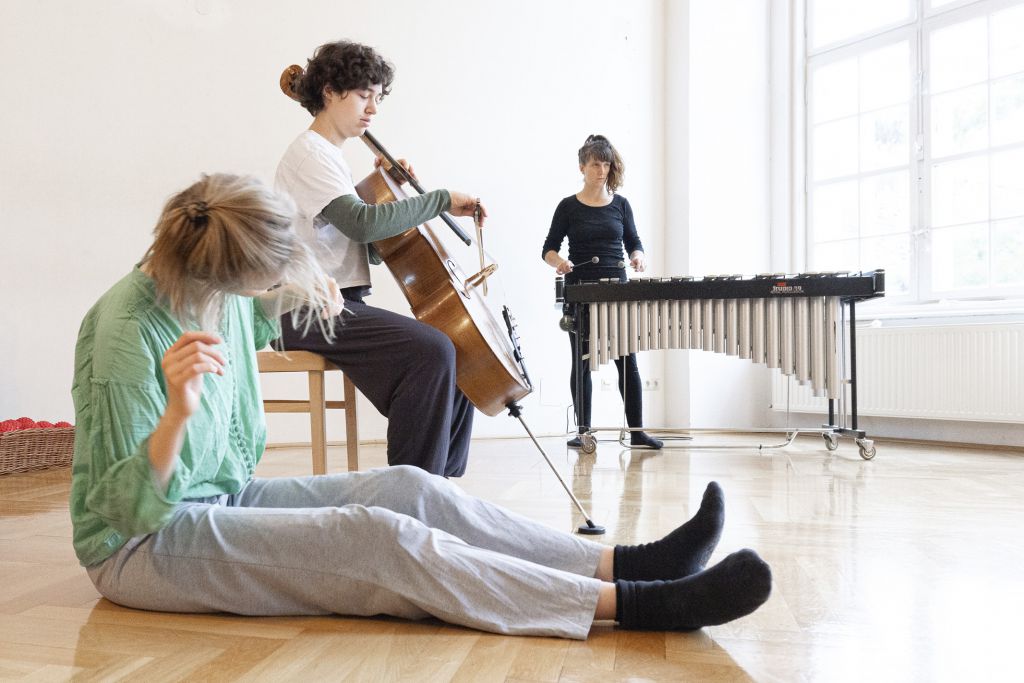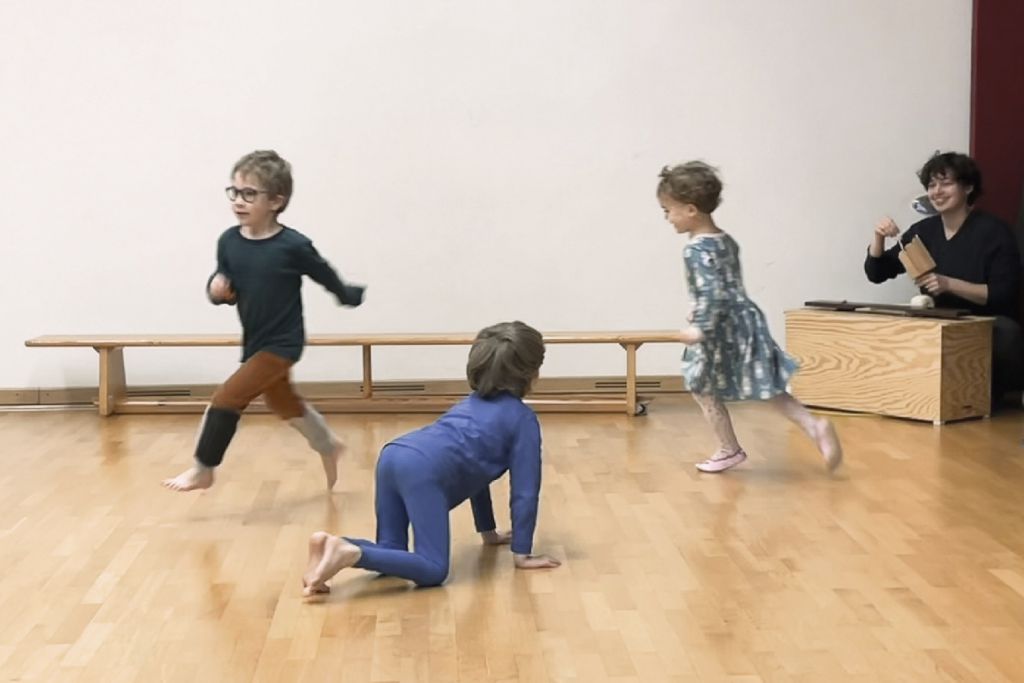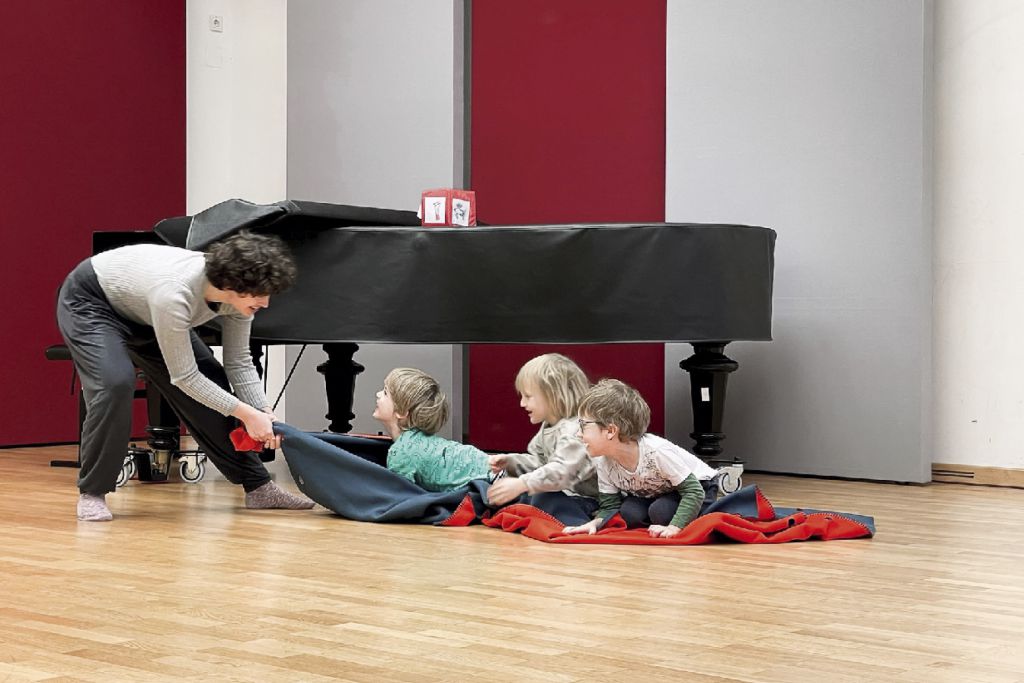The course offerings in Rhythmics at the Department of Music and Movement Education/Rhythmics and Music Physiology (MRM) are open to interested parties of all ages. In these courses, a joyful way of relating to music and movement, creative impulses for everyday life, and having fun being creative as a group all enjoy equal importance.
“What’s nice about what I’ve experienced in my course is that we ideally all wind up in a state of creative flow together. In times of isolation, it’s this social factor that I find most striking,” reports one course participant on his experiences. “For me, it’s a way of achieving some mental balance without any judgment or pressure to perform; it’s just pure creative experience.”

The field of music and movement pedagogy/rhythmics brings music together with the body, with movement, and with dance, doing so with an eye to the development and diversification of musical and motor skills. Here, interaction between music and movement forms the basis both for creative processes and for learning processes. “What we hear again and again when our participants give us feedback is that they had fun engaging creatively and playfully with music, movement, elements of dance, body percussion, and their own voices,” says Irmgard Bankl, who teaches at MRM and oversees its rhythmics offerings for adults. “Alongside lots of musical experiences as well as things that play out purely on the bodily level, like joint mobilisation and the release of tension, our participants also mention more complex phenomena like overcoming obstacles and adding depth to their self-expression, not to mention experiencing quiet or even just being able to achieve some calm.” No prior knowledge is necessary in order to participate in these low-threshold offerings. The only important thing is to enjoy and be interested in music and movement, improvisation, and creative processes.
This practice teaching of adults makes it possible for each participant to once again become more engaged with themselves and their inner child. It’s like a temporary escape from everyday life that’s relaxing and balancing.
Feedback from a group leader
The mdw’s rhythmics courses represent part of students’ practice teaching and can be attended by beginners as well as advanced participants of all ages. The group leaders are all in their final year of training at the mdw, as part of which they spend two semesters both planning and leading the courses on their own. They’re accompanied by mentors who serve as go-to persons but also support these student teachers in terms of self-reflection and analysis of their own teaching. These courses conclude with the students’ final examinations for their bachelor’s degrees—examinations that include participation by their respective course groups and with which they earn their teaching certificates for the subject of rhythmics for adults or children. “The rhythmics courses here at the mdw give rise to some nice synergies,” comments Hanne Pilgrim, who heads the University’s rhythmics programme. “Students obtain their required practical teaching experience, and their groups benefit from participating in free offerings that allow them to experience rhythm, music, and movement-related processes.” The students likewise view this as a valuable opportunity: “Every mdw faculty member who advises me helps me learn what I could do better, realise what I’d like to focus on in the lessons I give, and figure out how I can best adapt to the needs of my groups. It’s a great foundation, a way to practice for my career going forward.”
The team of practice teaching supervisors for the children’s and adults’ rhythmics courses consists of Irmgard Bankl, Jutta Goldgruber-Galler, Monika Mayr, and Tina Reif.

The programme of study now known as “Music and Movement Education” has its roots in the early 20th century, during which it developed out of a method originated by Émile Jaques-Dalcroze that aimed to provide learners with more nuanced options for musical expression on the basis of bodily sensitisation and articulation. This quickly gave rise to a successful music education concept—and today, the careers pursued by this programme’s graduates cover the fields of art and culture, education, social work, inclusion, and salutogenesis. Educational institutions specialised in elementary and social pedagogy, nurseries, music schools, and universities number among their places of work, as do centres of expertise focused on inclusion, diversity, and special education, rehabilitation centres, and outpatient therapy clinics, not to mention rhythmics and dance studios.
Thank you for allowing my son to participate. These rhythmics lessons are exactly what he needs!
Parent of a young participant
The audience addressed by mdw’s course offerings in rhythmics extends beyond just adults. While these courses can help adults’ various mental and physical blocks “melt away”, providing them with renewed access to their emotions and senses, the youngest course participants bring along some ideal qualities—curiosity, joy, and a tireless urge to move about and discover. Monika Mayr, who teaches at this department, bears responsibility for the children’s rhythmics courses: “This is a free and open offering for all children who would like to discover the world of art through music, movement, and language together with our rhythmics students.” Positive feedback confirms their success: “For us parents, it’s just wonderful to see how the children develop and blossom, how they jump around, sing, dance, and draw with so much cleverness and so full of new ideas once they’re back in their rooms at home.”
Cooperative arrangements, such as the one with the Stubenbastei primary school, make it possible for our students to familiarise themselves with a future career option. In turn, the school students benefit from these units of movement- filled musical instruction.

Every rhythmics lesson for children has its own theme as well as an underlying objective in terms of music and movement education, and the kids try out rhythm instruments and various materials while also expanding their experiences of sound and playing. In the process, rituals help the group to feel secure. “Every lesson begins with a song or a rhythmic chant accompanied by body instruments, which wakes up the body in a rhythmical sense. And the lessons end with a final song or chant, which provides the kids with a recognisable arc,” says Monika Mayr in description of these group sessions’ recurring elements. Improvisation on various instruments provides spontaneous support for the children’s movements, after which material can be felt out or a song can be experienced with all the senses.
In these rhythmics lessons, the children consciously experience their own creative abilities, strengthen their social skills, and sensitise their senses of hearing, sight, and touch. And as they acquire newfound self-confidence, positive reinforcement helps them to expand their ability to express themselves artistically. “I was a bear, a mouse, and a bunny rabbit today—and I danced! I really liked it!” exclaims four-year-old Andi with enthusiasm following a rhythmics lesson. His mother, too, is pleased with the student teachers’ dedicated work: “The educators here are extremely committed and very nice. And for every lesson, they think up new programming and bring along new instruments that then get played live. My child feels very comfortable, here, and he’s enthusiastic about participating.”
I attend these rhythmics courses because they’re both challenging and balancing and because they leave me feeling both alert and relaxed.
Feedback from an adult course participant
Regardless of whether the participants in a given course are adults or children, the rhythmics offerings at the mdw are a win-win situation for all participants—not least for the student teachers: “At the end of a lesson, once, a participant said to me, ‘That was exactly what I needed right now!’ Which was great for me to hear and affirmed what I was doing—because it showed me I was doing something right.”
Registration and course information:
rhythmik-kinder@mdw.ac.at (for children’s courses)
rhythmik-erwachsene@mdw.ac.at (for adult courses)
mdw.ac.at/mrm/mbe

